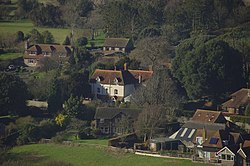Burpham, Sussex
| Burpham | |
| Sussex | |
|---|---|
 Burpham Village from Perry Hill | |
| Location | |
| Grid reference: | TQ039089 |
| Location: | 50°52’12"N, 0°31’30"W |
| Data | |
| Population: | 145 (2011) |
| Post town: | Arundel |
| Postcode: | BN18 |
| Dialling code: | 01903 |
| Local Government | |
| Council: | Arun |
| Parliamentary constituency: |
Arundel and South Downs |
Burpham is a rural village in Sussex, on an arm of the River Arun slightly less than two miles north-east of Arundel.
Burpham has one main street, mainly of thatched Sussex flint cottages. A slight minority of the population qualifies as within the working age.
Wepham is a rural hamlet in the parish about two miles north-east of Arundel on the road between Burpham and Warningcamp.
Parish church
The Church of England parish church, St Mary is of Saxon origin. It has a lepers' window by which lepers could watch the mass. It is a Grade I listed building.[1]
History
The surrounding area has yielded Iron Age and Neolithic remains including the bones of an elephant near Peppering Farm.
The village is next to the site of a Saxon Burh (an Old English term for "fortification") with earthworks to protect against Viking attack up the River Arun. It is one of a series of burhs ordered by Alfred the Great or his successor, Edward the Elder in about AD 900 and listed in the Burghal Hidage. The name 'Burpham' appears to be derived from burh.
Burpham has a rich literary history. Mervyn Peake and his family lived here and he walked the South Downs while devising the fantasy characters of Gormenghast. The author is buried at St Mary's church, Burpham.
John Cowper Powys moved to Burpham with his wife Margaret in 1902 and wrote warmly of Burpham in his Autobiography (1934).[2] His son Littleton Alfred Powys was born in the village later that year and subsequently grew up living with his mother whilst John Cowper Powys toured America delivering public lectures and writing.[3]
The Rev. Tickner Edwardes, who lived in what is now the Burpham Country House Hotel, when Vicar of Burpham, was a noted naturalist, and wrote many books including The Lore of the Honey-Bee, as well as authoring romantic novels and early films of the 1920s such as Tansy, the story of a love triangle between a village girl and two brothers.[4] A blue plaque on the building commemorates him. Both Peake and Edwardes are buried in St. Mary's churchyard. Like Gilbert White of Selbourne, Edwardes combined his role as priest with his love and knowledge of the natural world. As Vicar he encountered one Harold Dexter, leader of a Boys' Club from Mitcham in Surrey who were camped nearby. Harold was interested in bees; finding that the Vicar shared his interest he asked the Vicar whether he had come across a remarkable book on bee culture by a man named Tickner Edwardes. Replied the Vicar: I am Tickner Edwardes.
About the village
Burpham has notable views across the Arun and its water meadows towards Arundel Castle, Arundel Cathedral and Arundel Priory.
The village has a century-old cricket pitch where W. G. Grace played.
There is one public house, The George at Burpham, that was built in 1736.[5]
Outside links
| ("Wikimedia Commons" has material about Burpham, Sussex) |
References
- ↑ National Heritage List 1027657: The Parish Church of St Mary (Grade I listing)
- ↑ London: Macdonald, 1967, pp.316-84.
- ↑ "Descents of Memory - The Life of John Cowper Powys" - M Krissdottir pub Duckworth 2007
- ↑ Tansy (1921) Petley, Julian. BFI Screen Online. Retrieved 02-10-2010.
- ↑ The George at Burpham, Burpham, Arundel
- Nikolaus Pevsner: The Buildings of England: Sussex, 1965 Penguin Books ISBN 978-0-300-09677-4
